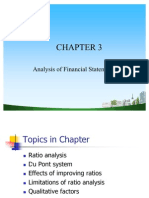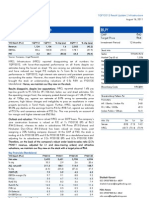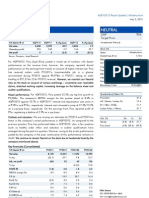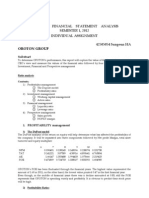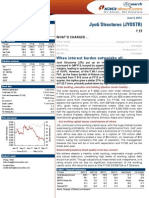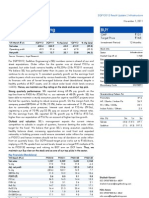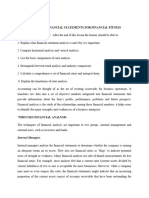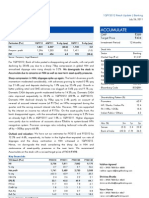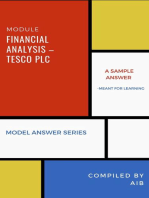Suggested Answer - Syl2012 - Jun2014 - Paper - 20 Final Examination: Suggested Answers To Questions
Suggested Answer - Syl2012 - Jun2014 - Paper - 20 Final Examination: Suggested Answers To Questions
Uploaded by
MdAnjum1991Copyright:
Available Formats
Suggested Answer - Syl2012 - Jun2014 - Paper - 20 Final Examination: Suggested Answers To Questions
Suggested Answer - Syl2012 - Jun2014 - Paper - 20 Final Examination: Suggested Answers To Questions
Uploaded by
MdAnjum1991Original Description:
Original Title
Copyright
Available Formats
Share this document
Did you find this document useful?
Is this content inappropriate?
Copyright:
Available Formats
Suggested Answer - Syl2012 - Jun2014 - Paper - 20 Final Examination: Suggested Answers To Questions
Suggested Answer - Syl2012 - Jun2014 - Paper - 20 Final Examination: Suggested Answers To Questions
Uploaded by
MdAnjum1991Copyright:
Available Formats
Suggested Answer_Syl2012_Jun2014_Paper_20
Academics Department, The Institute of Cost Accountants of India (Statutory Body under an Act of Parliament) Page 1
FINAL EXAMINATION
GROUP IV
(SYLLABUS 2012)
SUGGESTED ANSWERS TO QUESTIONS
JUNE 2014
Paper- 20 : FINANCIAL ANALYSIS & BUSINESS VALUATION
Time Allowed : 3 Hours Full Marks : 100
The figures in the margin on the right side indicate full marks.
Section A
Answer Question No. 1 and Question No. 2 which are compulsory
carrying 15 marks each and any two from the rest in this Section.
1. The following financial data for five years has been extracted from the Annual Report
2012-13 of one of the world's largest generic pharmaceutical companies having a strong
presence in over 170 countries. Though the company's mission is 'To be a leading global
healthcare company which uses technology and innovation to meet everyday needs of
all patients', yet it also wants to keep its shareholders happy by giving them a fair rate of
return. For gauging return for shareholders, the company is using Return on Equity (ROE) as
one of the metrics of performance evaluation. Because of intense competition, in recent
years, its ROE is under pressure and to maintain the level of ROE, the company is changing
its business model - in that, it is varying its margins, assets utilization and leverage.
(i) You are required to use DU PONT Analysis using the financial data given below and
show how the ROE of the company is changing due to change in its margins, assets
utilization and leverage over the period of five years. 12
(ii) You are also required to give your comments on the trend on these parameters. 3
(` in Crores)
Statement of Profit and Loss 2009 2010 2011 2012 2013
Total Revenue 5,315.82 5,713.24 6,422.73 7,125.80 8,431.55
Profit before Tax 901.31 1,324.99 1,151.39 1,421.46 2,011.86
Profit after Tax 776.81 1,081.49 960.39 1,123.96 1,507.11
Dividend 155.46 160.58 224.81 160.58 160.58
Tax on Dividend 26.42 26.67 36.72 26.05 27.29
Retained Earnings 594.93 894.24 698.86 937.32 1,319.24
Balance Sheet 2009 2010 2011 2012 2013
ASSETS:
Fixed Assets 2,358.81 2,695.41 3,120.72 3,346.11 3,768.63
Investments (Current and
Non-Current)
81.32 265.10 570.65 1,035.15 2,601.82
Other Net Assets (Current and
Non-Current
3,015.01 3,137.80 3,574.51 3,413.67 3,746.08
Suggested Answer_Syl2012_Jun2014_Paper_20
Academics Department, The Institute of Cost Accountants of India (Statutory Body under an Act of Parliament) Page 2
Total 5,455.14 6,098.31 7,265.88 7,794.93 10,116.53
EQUITY AND LIABILITIES:
Share Capital 155.46 160.58 160.58 160.58 160.58
Reserves and Surplus 4195.29 5753.51 6452.37 7389.70 8708.94
Net Worth 4350.75 5914.09 6612.95 7550.28 8869.52
Loan Funds (Current and
Non-Current)
940.24 5.07 440.48 12.20 965.81
Deferred Tax 164.15 179.15 212.45 232.45 281.20
Total 5455.14 6098.31 7265.88 7794.93 10116.53
Answer:
1. Extended DuPont Analysis provides the drivers of ROE in terms of margins, assets utilization
and leverage thereby provides important information in understanding business model of
a company. Extended DuPont Analysis decomposes ROE into three components as given
below:
ROE = (PAT / Sales) x (Sales / Assets) x (Assets / Equity)
The above equation shows that ROE is driven by Profit Margin (PAT / Sales), Assets
Utilization or Assets Turnover (Sales / Assets) and how much of the assets are financed by
equity and debt, i.e. a measure of leverage (Assets / Equity)
Using the above decomposition, we obtain various decomposed components of ROE
over a period of five years which are given below:
2009 2010 2011 2012 2013
ROE 17.848% 18.287% 14.527% 14.878% 16.989%
PAT / SALES 14.613% 18.930% 14.953% 15.773% 17.875%
SALES TO ASSETS 0.974 0.937 0.884 0.914 0.833
ASSETS TO EQUITY (NET WORTH) 1.254 1.031 1.099 1.032 1.141
The Company saw a sharp decline in ROE in year 2011 which was primarily due to
reduction in Profit Margins (from 18.93% to 14.953%) as well as reduction in the assets
utilization; which may hint that the company (or perhaps the industry) might be having a
tough time in pushing sales; situation improved in 2012 and 2013 and the main driver was
Profit Margin. The big increase in ROE in 2013 came primarily from Profit Margin and
Leverage; had the company increased its assets utilization ROE would have increased
further; seeing the trends it is clear that the biggest challenge before the company is to
increase assets utilization.
2. Following are the financial data for last four years of a company:
Amount ` in lakhs
Year 2010 2011 2012 2013
Equity Share (`10 each) 100 100 100 100
Reserve 100 100 100 100
10% Debt 100 120 180 200
EBIT 20 30 56 70
P/E Ratio 10 12 10 12
Tax Rate 30%
Find for all the years:
Suggested Answer_Syl2012_Jun2014_Paper_20
Academics Department, The Institute of Cost Accountants of India (Statutory Body under an Act of Parliament) Page 3
(a) NOP AT, ROCE, EPS, Market value per share, ROE, Earnings Yield, Market value to Book
value ratio and comment on the profitability and growth expectation. 11
(b) Debt-Equity (D/E) ratio and make an analysis of financial risk over the years based on
D/E ratio and DFL (Degree of Financial Leverage) and explain if you find any difference
in the interpreted results. 4
Answer:
2. (a)
(Amount in lakhs / ` in lakhs)
Year 2010 2011 2012 2013
EBIT 20 30 56 70
Interest 10 12 18 20
EBT 10 18 38 50
DFL = EBIT/EBT 2 1.666667 1.473684 1.4
Equity Shareholders Funds 200 200 200 200
Debt Equity Ratio 0.5 0.6 0.9 1
EAT 7 12.6 26.6 35
No of Shares 10 10 10 10
EPS 0.7 1.26 2.66 3.5
Market Value per Share 7 15.12 26.6 42
NOPAT 14 21 39.2 49
CE 300 320 380 400
ROCE 4.666667 6.5625 10.31579 12.25
Book Value 20 20 20 20
Market Value to Book Value 0.35 0.756 1.33 2.1
Earn. Yield 10 8.333333 10 8.333333
ROE 3.5 6.3 13.3 17.5
Alternatively ROCE can also be calculated as follows:
ROCE (EBIT/ Capital employed) 6.66667 9.375 14.73684 17.5
(b) Financial risk is increasing over the years as indicated by D/E ratio; just the reverse is
indicated by DFL. DFL recognizes the firm's increasing profit generating ability in reducing
the riskiness of the increased debt.
Percentage increase year to year basis:
Year 2011 2012 2013
NOPAT 50 86.67 25
ROCE 40.63 57.19 18.75
ROE 80 111.11 31.58
EPS 80 111.11 31.58
MPS 116 75.93 57.90
(i) Earning Yield is 10 in the year 2010, however decreased to 8.333333 in the year 2011, again
increased to 10 in the year 2012, and decreased to 8.333333 in the year 2013.
(ii) Market Value to Book Value ratio is 0.35 in the year 2010, however increased to 0.756 in the
year 2011, and again increased to 1.33 and 2.1 in the year 2012 and 2013.
Suggested Answer_Syl2012_Jun2014_Paper_20
Academics Department, The Institute of Cost Accountants of India (Statutory Body under an Act of Parliament) Page 4
3. M. Ltd. is considering a new product line to supplement its range line. It is anticipated that
the new product line will involve cash investment of ` 7,00,000 at time 0 and ` 10,00,000 in
Yr 1. After tax cash inflows of ` 2,50,000 are expected in year 2, ` 3,00,000 in year 3, `
3,50,000 in Yr 4, and ` 4,00,000 in each year thereafter through year 10. Though the product
line might be viable after year 10, the company prefers to be conservative and end all
calculation at that time.
(i) If the required rate of return is 15%, what is the NPV of the project and is it acceptable?
3
(ii) What is its IRR? 3
(iii) What would be the case if the required rate of return was 10%? 2
(iv) What is the project's Pay Back Period? 2
Years P.V. Factor
Year 1
P.V. Factor
Year 2
P.V. Factor
Year 3
P.V. Factor
Year 4
PVIFA for
10 years
Discounting Factor @ 13% 0.885 0.783 0.693 0.613 5.426
Discounting Factor @ 14% 0.877 0.769 0.675 0.592 5.215
Discounting Factor @ 15% 0.870 0.756 0.658 0.572 5.020
Answer:
3. (i)
YEAR CASH FLOW
(`)
PRESENT VALUE
DISCOUNT FACTOR (15%)
PRESENT
VALUE (`)
0 (700000) 1.000 (700000)
1 (1000000) 0.870 (870000)
2 250000 0.756 189000
3 300000 0.658 197400
4 350000 0.572 200200
5-10 (Total of 6 Years) 400000 2.164* 865600**
Net Present Value `(1,17,800)
Because the net present value is negative, the project is unacceptable.
(ii) The internal rate of return is 13.21%. if the trial and error method were used, we have
the following:
YEAR CASH FLOW
(`)
DISCOUNT FACTOR
(14%)
PRESENT VALUE
(14%) (`)
DISCOUNT
FACTOR (13%)
PRESENT VALUE
(`) (13%)
0 (7,00,000) 1.000 (7,00,000) 1.000 (7,00,000)
1 (10,00,000) 0.877 (8,77,000) 0.885 (8,85,000)
2 2,50,000 0.769 192,250 0.783 1,95,750
3 3,00,000 0.675 2,02,500 0.693 2,07,900
4 3,50,000 0.592 2,07,200 0.613 2,14,550
5-10 4,00,000 2.302* 9,20,800** 2.452* 9,80,800**
Net Present Value = ` (54,250) `14,000
*PVIFA for 10 yrs minus PVIFA for 4 years.
**Total for years 5-10
To approximate the actual rate, we interpolate between 13 & 14 percent as follows
Discounting Factor (%) NPV (`)
13 14,000
IRR (X) Zero
14 -54,250
By simple interpolation we get X - 13 / 14 13 = 0 - 14,000 / -54,250 - 14,000
Suggested Answer_Syl2012_Jun2014_Paper_20
Academics Department, The Institute of Cost Accountants of India (Statutory Body under an Act of Parliament) Page 5
Or X(IRR) = 13.205 or 13.21%.
Because the internal rate of return is less than the required rate of return, the project
would not be acceptable.
(iii) The project would be acceptable as then IRR (13.21%) will exceed the required rate of
return (10%)
(iv) Payback period = 6 years (-` 7,00,000 - ` 10,00,000 + ` 2,50,000 + ` 3,00,000 + ` 3,50,000
+ ` 4,00,000 + ` 4,00,000 = 0)
4. (a) Compute the Liquid Ratio from the following information for the year ended 31st March,
2014 and also interpret the result: 6
Particulars `
Land and Building 55,000
Plant and Machinery 40,000
Stock 30,000
Debtors 42,000
Bills receivable 25,000
Prepaid Expense 5,000
Cash at bank 15,000
Cash in hand 10,000
Creditors 25,000
Outstanding Salary 5,000
Bank Overdraft 3,000
Bills payable 4,000
Proposed Dividend 6,000
Long Term Liabilities 46,000
Provision for Bad debts 2,000
(b) Using Altman's Multiple Discriminant Function, calculate Z - score of Neel & Co. Ltd.,
where the five accounting ratios are as follows and comment about its financial
position: 4
Working Capital to Total Assets = 0.250
Retained Earnings to Total Assets = 50%
EBIT to Total Assets =19%
Book Value of Equity to Book Value of Total Debt = 1.65
Sales to Total Assets = 3 times
Answer:
4. (a)
Compute the Liquid Assets and Liquid Liabilities
Liquid Assets ` `
Debtors
Less : Provision for Bad
debts
Bills receivable
Cash at Bank
Cash in Hand
42,000
2,000
40,000
25,000
15,000
10,000
90,000
Suggested Answer_Syl2012_Jun2014_Paper_20
Academics Department, The Institute of Cost Accountants of India (Statutory Body under an Act of Parliament) Page 6
Liquid Liability ` `
Creditors
Outstanding Salary
Bills payable
Proposed Dividend
25,000
5,000
4,000
6,000
40,000
Liquid ratio = Liquid Assets / Liquid Liabilities = `90,000 / ` 40,000 = 2.25 : 1
Interpretation and Significance:
It has already been stated that liquid ratio is, practically, the true test of liquidity. It
measures the capacity of the firm to pay - off its liabilities as soon as they become
mature for payment. Thus, a high liquid ratio indicates that the firm is quite able to pay
- off its current obligations without difficulty, whereas, a low liquid ratio will create an
opposite situation i.e. it is not possible for the firm to pay - off its current obligations,
which indicates the liquidity position is not sound at all.
Although it is stated that a 1 : 1 ratio is considered as good but the same cannot safely
be concluded since if percentage of debtors is more than other liquid assets, and if
the same is not realized (if the debtors do not pay), it indicates that problem will arise
to liquidate current obligations although the normal liquid ratio is maintained. Similarly,
a low liquid ratio does not always mean a bad liquidity position since stocks are not
absolutely non-liquid in character. Thus, a high liquid ratio does not always prove a
satisfactory liquidity position if the firm has slow paying customers, and vice versa in the
opposite case i.e. a low liquid ratio may yet indicate a sound liquidity position if the
firm has fast moving stocks.
(b) As the Book Value of Equity to Book Value of Total Debt is given in the probl em in
place of Market value of equity to Book Value of Total Debt, the value of Z - score is to
be computed as per Altman's 1983 Model of Corporate Distress Prediction instead of
Altman's 1968 Model of Corporate Distress Prediction that is otherwise followed.
As per Altman's Model (1983) of Corporate Distress Prediction,
Z = 0.717X1 + 0.847X2+ 3.107X3 + 0.420X4 + 0.998X5
Here, the five variables are as follows:
X1 = Working Capital to Total Assets = 0.250
X2= Retained Earnings to Total Assets = 0.50
X3= EBIT to Total Assets = 0.19
X4 = Book Value of Equity Shares to Book Value of Total Debt = 1.65
X5 = Sales to Total Assets = 3 times
Hence, Z - score =(0.717 x 0.25) + (0.847 x 0.50) + (3.107 x0.19) + (0.420 x1.65) + (0.998 x3)
= 0.17925 + 0.4235 + 0.59033 + 0.693 + 2.994 = 4.88
Note: As the calculated value of Z - score is much higher than 2.99, it can be strongly
predicted that the company is a non - bankrupt company (i.e. non failed company)
5. The following information is given regarding Shaan Ltd. Some key ratios are provided for
the particular industry to which Shaan Ltd. belongs. You are required to calculate the
relevant ratios for Shaan Ltd., compare them with that particular industry norms and give
the comments on the performance of the company. 10
The following balances are available from the books of accounts of Shaan Ltd. as at 31st
March, 2014:
Equity Share Capital ` 27,00,000, 12% debentures ` 5,00,000, Sundry Creditors ` 3,80,000,
bills payable ` 3,20,000 and other current liabilities ` 2,00,000, Net fixed assets ` 17,00,000,
cash ` 4,00,000, Sundry Debtors ` 7,50,000 and stock ` 12,50,000.
The sales of the company for the year ending 31.03.2014 amounted to ` 60,00,000 and the
gross profit was ` 17,00,000.
Suggested Answer_Syl2012_Jun2014_Paper_20
Academics Department, The Institute of Cost Accountants of India (Statutory Body under an Act of Parliament) Page 7
Industry Norms Ratio Considered
Current Ratio (CA/CL) 2.4
Sales/Debtors 7.7
Sates/Stock 7.9
Sales/Total assets 2.39
Gross Profit Ratio 36%
Answer:
5. (a) Calculation of Ratios:
(1) Current Ratio =
Current Assets 24, 00, 000
=
Current Liabilities 9, 00, 000
`
`
= 2.67 : 1
(2) Sales / Debtors =
Sales 60, 00, 000
=
Debtors 7, 50, 000
`
`
= 8.00
(3) Sales / Stock =
Sales 60, 00, 000
=
Stock 12, 50, 000
`
`
= 4.80
(4) Sales / Total Assets =
Sales 60, 00, 000
=
Total Assets 41, 00, 000
`
`
= 1.46
(5) Gross Profit Ratio =
Gross Profit 17, 00, 000
x 100 = x 100
Sales 60, 00, 000
`
`
= 28.33%
Comparison of Shaan Ltd's ratios with Industry Norms
Ratio Shaan Ltd. Industry Comments
(1) Current
Ratio
2.67 2.4 The current ratio of the company indicates better short -
term solvency position as compared to the industry. But
the composition of the current assets has to be analysed
to ascertain any excess investments in current assets.
(2) Sales /
Debtors
8.00 7.7 The company's average debtor's collection period is
marginally less than the industry and it indicates better
management of receivables.
(3) Sales /
Stock
4.80 7.9 It indicates excess carrying of inventory as compared to
the industry. The low turnover ratio may also be due to
lower sales volume.
(4) Sales/
Total Assets
1.46 2.39 The company has either excess investments in fixed
assets or lower sales performance.
(5) Gross
Profit Ratio
28.33% 36% The gross profit margin is much less than the industry
average, it may be due to high cost of production, lower
selling price or weak market penetration due to which
company has to keep lower margins to achieve sales,
etc.
Section B
Answer Question No. 6 and Question No. 7 which are compulsory
carrying 15 marks each and any two from the rest in this Section.
6. (a) Bihari Ltd. is issuing 5% ` 25 at par preference shares that would be convertible after
three years to equity shares at ` 27. If the current market price of equity shares is `
13.25, what is the conversion value and conversion premium?
The convertibles are trading at ` 17.75 in the market. Assume expected return as 8%. 6
Suggested Answer_Syl2012_Jun2014_Paper_20
Academics Department, The Institute of Cost Accountants of India (Statutory Body under an Act of Parliament) Page 8
(b) Following is the information of two companies for the year ended 31st March, 2014:
Particulars Company A Company B
Equity shares of ` 10/- each ` 8,00,000 ` 10,00,000
10% Pref. Shares of ` 10/- each ` 6,00,000 ` 4,00,000
Profit after tax ` 3,00,000 ` 3,00,000
Assume the market expectation is 18% and 80% of the profits are distributed.
Required
(i) What is the rate you would pay for the equity shares of each company? 3
(a) If you are buying a small lot.
(b) If you are buying controlling interest shares.
(ii) If you plan to invest only in preference shares which company's preference shares
would you prefer? 3
(iii) Would your rates be different for buying small lot, if the company 'A' retains 30%
and company 'B' 10% of the profits. 3
Answer:
6. (a) Conversion ratio =
Par value of Conversion security
Conversion price
= 25/27 = 0.9259
Conversion value = (Conversion ratio) x (Market value per share of the common stock)
= (0.9259) x (` 13.25) = `12.27
Now let us find the value as straight preferred stock = 1.25 / 0.08 = ` 15.63 (Preference
dividend / expected return)
(
(
(
(
(
(
value conversion
and value security
the of higher
stock preferred
e convertibl the
of Price Market
= terms) absolute (in premium Conversion
= ` 17.75 ` 15.63 = ` 2.12
(b) (i) (a) Buying a small lot of equity shares: If the purpose of valuation is to provide data
base to aid a decision of buying a small (non-controlling) position of the equity
of the companies, dividend capitalization method is most appropriate. Under
this method, value of equity share is given by:
Dividend per share
x100
Market capitalisation rate
Company A : `
2.4
18
x 100 = ` 13.33
Company B : `
2.08
18
x 100 = ` 11.56
(b) Buying controlling Interest equity shares: If the purpose of valuation is to provide
data base to aid a decision of buying controlling interest in the company, EPS
capitalization method is most appropriate. Under this method, value of equity
is given by:
Earning per share (EPS)
x 100
Market capitalisation rate
Company A : `
3
18
x 100 = ` 16.67
Company B : `
2.6
18
x 100 = ` 14.44
(ii) Preference Dividend coverage ratios of both companies are to be compared to
Suggested Answer_Syl2012_Jun2014_Paper_20
Academics Department, The Institute of Cost Accountants of India (Statutory Body under an Act of Parliament) Page 9
make such decision.
Preference dividend coverage ratio is given by:
Profit after tax
x 100
Preference Dividend
Company A : `
3, 00, 000
60, 000
= 5 times or 500%
Company B : `
3, 00, 000
40, 000
= 7.5 times or 750%
If we are planning to invest only in preference shares, we would prefer shares of B
Company as there is more coverage for preference dividend.
(iii) Yes, the rates will be different for buying a small lot of equity shares, if the company
'A' retains 30% and company 'B' 10% of profits.
The new rates will be calculated as follows:
Company A : `
2.1
18
x 100 = ` 11.67
Company B : `
2.34
18
x 100 = ` 13.00
Working Notes:
1. Computation of earnings per share and dividend per share (companies distribute
80% of profits)
Company A Company B
Profit after tax 3,00,000 3,00,000
Less: Preference dividend 60,000 40,000
Earnings available to equity shareholders (A) 2,40,000 2,60,000
Number of Equity Shares (B) 80,000 1,00,000
Earnings per share (A/B) 3.0 2.60
Retained earnings 20% 48,000 52,000
Dividend declared 80% (C) 1,92,000 2,08,000
Dividend per share (C/B) 2.40 2.08
2. Computation of Dividend per share (Company A 30% and Company B 10% of
profits)
Company A Company B
Earnings available to equity shareholders `2,40,000 `2,60,000
Number of Equity Shares 80,000 1,00,000
Retained Earnings `72,000 `26,000
Dividend Distributed `1,68,000 `2,34,000
Dividend per share `2.10 `2.34
7. (a) Consider two firms that operate independently and have the following financial
characteristics:
(` in Millions)
Firm A Firm B
Revenues 8,000 4,000
Cost of goods sold 6,000 2,400
EBIT 2,000 1,600
Expected growth rate 4% 6%
Suggested Answer_Syl2012_Jun2014_Paper_20
Academics Department, The Institute of Cost Accountants of India (Statutory Body under an Act of Parliament) Page 10
Cost of capital 9% 10%
Both firms are in steady state with capital spending offset by depreciation. Both firms
have an effective tax rate of 50% and are financed only by equity.
Scenario I
Assume that the combining of the two firms will create economies of scale that will
reduce the cost of goods sold to 65%.
Scenario II
Assume that as a consequence of the merger the combined firm is expected to
increase its future growth to 6% while cost of goods sold remains at 70% and does not
come down to 65%.
Scenario I and Scenario II are mutually exclusive.
You are required to:
(i) Compute the value of both the firms as separate entities. 3
(ii) Compute the value of both the firms together if there were absolutely no synergy at
all from the merger (Scenario III). 1
(iii) Compute the cost of capital and the expected growth rate for the combined entity.
2
(iv) Compute the value of synergy in Scenario I and Scenario II. 3
(b) From the following information and particulars of Salim Ltd. for the year ended
31.03.2014, calculate
(1) Book Value per share, (2) Earnings per share, (3) Dividend yield, (4) Earning yield,
(5) P/E Ratio and (6) P/B Ratio. 6
The information which is available from the Books of Accounts of Salim Ltd. is as
follows:
(All in ` lakhs)
Sales - 18.26, Cost of goods sold - 10.25, Administrative expenses - 0.46, selling and
distribution expenses - 1.47, Depreciation - 1.05, Interest on debt - 1.13, Tax provision -
1.08, Proposed dividend - 0.90, Equity share capital (consisting of 7,000 equity shares of
` 100 each) 7.00, Reserve & Surplus - 1.15, 8% Debentures - 9.0, 9% Public deposits -
3.4, Trade creditors - 3.28, Outstanding liabilities for expenses 0.23, and Fixed assets
(less accumulated depreciation of 4.6) 15.6. Monthly average market price per share
during month of March, 2014 was ` 247. Industry averages: P/E ratio 10, P/B 1.6,
Dividend yield 8%.
Answer:
7. (a) (i) In the absence of any information regarding P/E or pay out ratio, the following
model may be used for valuation of the firm:
PAT(1+g)
Ke- g
Firm A Value =
1000(1.04)
0.09- 0.04
= ` 20,800 million
Firm B Value =
800(1.06)
0.10 - 0.06
= ` 21,200 million
(ii) Value of both firm without synergy = 20,800 + 21,200 = 42,000 million
(iii) Weighted cost of Capital for the combined entity
9% x
20, 800
42, 000
+ 10% x
21, 200
42, 000
= 9.504%
Expected growth rate for the combined entity
Suggested Answer_Syl2012_Jun2014_Paper_20
Academics Department, The Institute of Cost Accountants of India (Statutory Body under an Act of Parliament) Page 11
4% x
20, 800
42, 000
+ 6% x
21, 200
42, 000
= 5.01%
(iv) Value of Synergy
Scenario I
Revenues `(8,000 + 4,000) `12,000 million
COGS (65%) ` 7,800 million
EBIT `4,200 million
PAT `2,100 million
Cost of Capital 9.504%
g 5.01%
Value =
2,100(1.0501)
(0.09504 - 0.0501)
= `49,070.09 million
Value of synergy = `(49,070.09 42,000)million = ` 7,070.09 million
Scenario II
Revenues `12,000 million
COGS (70%) `8,400 million
EBIT `3,600 million
PAT `1,800 million
Cost of Capital 9.504%
g 6% (5% for combination without synergy)
Value =
1, 800(1.06)
(0.09504 - 0.06)
= ` 54,452.06 million
Synergy Value =`(54,452.06 42,000)million = ` 12,452.06 million
(b)
Income Statement of Salim Ltd
for the year ended 31.03.2014 (All in ` lakhs)
Sales 18.26
Less: Cost of Goods Sold 10.25
Gross Margin 8.01
Less: Administrative Expenses 0.46
Selling and Distribution Expenses 1.47
Depreciation 1.05
Interest on debt 1.13 4.11
Profit before Tax 3.9
Less: Tax Provision 1.08
Net Profit 2.82
Computation of the ratios of Salim Ltd:
(i) Book value per share =
Share holders Fund
No. of Shares
116.43
7,000
lakhs 8.15
Shares of No.
Surplus & Reserve Capital Share Equity
`
`
= =
+
=
(ii) Earnings per share =
Profit after Tax
Total No. of Shares
2.82 lakhs
=
7, 000
`
= ` 40.29
(iii) Dividend Yield =
Dividend Per Share
Market Price per share
12.86
=
247
`
`
= 5.21%
Suggested Answer_Syl2012_Jun2014_Paper_20
Academics Department, The Institute of Cost Accountants of India (Statutory Body under an Act of Parliament) Page 12
(iv) Earning Yield =
Earning Per Share
Market Price per share
40.29
=
247
`
`
= 16.31%
(v) Price earnings Ratio =
Market Price per share
Earning Per Share
247
=
40.29
`
`
= 6.13 or 6 times
(vi) Price Book Value ratio =
Market Price per share
Book Value Per Share
247
=
116.43
`
`
= 2.12
8. (a) What are the types of companies where management may find difficulties in using
Discounted Cash Flow Technique for Valuation? 4
(b) The following information is available pertaining to Smart Televisions Ltd. for the
financial year ending on 31.03.2014.
Particulars Amount (` in Crores)
Sales 250
Profit after tax 40
Book value 100
The valuer appointed by the company believes that 50% weightage should be given
to the earnings in valuation process. He also believes that equal weightage may be
given to sales and book value. He has identified three firms viz., Alpha Ltd., Beta Ltd.,
and Gamma Ltd., which are comparable to the operations of Smart Televisions Ltd.
Particulars Alpha Ltd.
(` in Crores)
Beta Ltd.
(` in Crores)
Gamma Ltd.
(` in Crores)
Sales 190 210 270
Profit after tax 30 44 50
Book value 96 110 128
Market value 230 290 440
Compute the value of Smart Televisions Ltd. using the comparable firms approach. 6
Answer:
8. (a) Types of companies where we may find difficulties in using discounted cash flow
Valuation are:
- Private firm, where the owner is planning to sell the firm. It is difficult to find out the
extent of success of the private firm, due to the owner's special skills and contacts.
- A biotechnology firm, with no current products or sales, but with several promising
product patents in the pipeline. Difficulty may be in estimating near term cash
flows.
- A cyclical firm, during recession. The subsequent impact could be adverse/
worsening debt/equity ratios and ROI may also be affected which may create
problems.
- A troubled firm, which is in the process of restructuring, where it is selling some of its
assets and changing its financial mix. Difficulties are faced in using historical data
for earnings growth and cash flows of the firm.
- A firm which owns a lot of valuable land which is currently unutilized. Difficulties are
that unutilized assets do not produce cash flows.
(b) Valuation multiples for the comparable firms can be calculated as follows:
Particulars Alpha Ltd.
` Crores
Beta Ltd
` Crores
Gamma Ltd.
` Crores
Average
Price / Sales Ratio 1.21 1.38 1.63 1.41
Price / Earnings Ratio 7.67 6.59 8.80 7.69
Price / Book value Ratio 2.40 2.64 3.44 2.83
Suggested Answer_Syl2012_Jun2014_Paper_20
Academics Department, The Institute of Cost Accountants of India (Statutory Body under an Act of Parliament) Page 13
Applying the multiples calculated as above, the value of Smart Televisions Ltd. can be
calculated as follows:
Particular Average Multiple Parameter Value ` Crores
Price / Sales Ratio 1.41 250 352.50
Price / Earnings Ratio 7.69 40 307.60
Price / Book value Ratio 2.83 100 283.00
By applying the weightage to the P/S ratio, P/E ratio and P/BV ratio we get:
[(352.50 x 1)+(307.60 x 2)+(283.00 x 1)]/(1+2+1)=312.675, i.e. ` 312.675 crores is the value.
Working Notes:
Price/Sales Ratio =
Sales
Value Market
Price/Earnings Ratio =
tax after Profit
Value Market
Price/Book value ratio =
Value Book
Value Market
9. Following information is available in respect of XYZ Ltd. which is expected to grow at a
higher rate for four years after which growth rate will stabilize at a lower level:
Base year information ` in crores
Revenues
EBIT
Capital expenditure
Depreciation
2,000
300
280
200
Information for high growth and stable growth period is as follows:
High Growth Stable Growth
Growth in Revenue & EBIT 20% 10%
Growth in capital expenditure and depreciation 20% Capital expenditure is
offset by depreciation
Risk free rate 10% 9%
Equity beta 1.15 1
Market risk premium 6% 5%
Pre-tax cost of debt 13% 12.86%
Debt equity ratio 1 : 1 2:3
For all time, working capital is 25% of revenue and corporate tax rate is 30%.
What is the value of the firm? Use rate of discounting @ 13%. 10
Year 1 2 3 4
P. V. Factor @ 13% 0.885 0.783 0.693 0.613
Answer:
9. High Growth Phase:
ke = 0.10+ 1.15x0.06 = 0.169 or 16.9%
kd = 0.13x (1-0.3) = 0.091 or 9.1%
Cost of Capital = 0.5 x 0.169 + 0.5 x 0.091 = 0.13 or 13%
Stable Growth Phase:
Suggested Answer_Syl2012_Jun2014_Paper_20
Academics Department, The Institute of Cost Accountants of India (Statutory Body under an Act of Parliament) Page 14
ke = 0.09 + 1.0 x 0.05 = 0.14 or 14%
kd = 0.1286 x (1 - 0.3) = 0.09 or 9%
Cost of Capital = 0.6 x 0.14 + 0.4 x 0.09 = 0.12 or 12%
Determination of forecasted free Cash Flow of the Firm (FCFF)
(` in Crores)
Yr.1 Yr.2 Yr.3 Yr.4 Terminal Year
Revenue 2,400 2,880 3,456 4,147.20 4,561.92
EBIT 360 432 518.40 622.08 684.29
NOPAT = EBIT*(l-t) 252 302.40 362.88 435.46 479.00
Capital Expenditure less Depreciation 96 115.20 138.24 165.89 -
Increase in Working Capital 100.00 120.00 144.00 172.80 103.68
Free Cash Flow (FCF) 56.00 67.20 80.64 96.77 375.32
Present Value (PV) of FCFF during the explicit forecast period is:
FCFF (` in Crores) PVF @ 13% PV (` in Crores)
56.00 0.885 49.56
67.20 0.783 52.62
80.64 0.693 55.88
96.77 0.613 59.32
`217.38
PV of the terminal, value is:
375.32 1
x
4
0.12 - 0.10
(1.13)
= ` 18,766 Crores x 0.613 = ` 11,504 Crores
The value of the firm is: ` 217.38 Crores + ` 11,504 Crores = 11,721 Crores
10. Following is the information collected for a company, provided to you:
BALANCE SHEET OF XYZ LTD AS AT 31st MARCH
(` in Crores)
Particular 2013
EQUITY AND LIABILITIES:
SHAREHOLDER'S FUNDS
Share capital
Reserves and Surplus
NON-CURRENT LIABILITIES
Long-term Borrowings
Deferred tax liabilities (Net)
Other long-term liabilities
Long-term provisions
CURRENT LIABILITIES
Trade payables
Other current liabilities
Short-term provisions
TOTAL
ASSETS
36.37
2,225.66
2,262.03
6,322.76
39.39
7.09
355.03
6,724.27
1,797.88
12.24
19.00
1,829.11
10,815.41
Suggested Answer_Syl2012_Jun2014_Paper_20
Academics Department, The Institute of Cost Accountants of India (Statutory Body under an Act of Parliament) Page 15
NON-CURRENT ASSETS
FIXED ASSETS:
Tangible assets
Capital work-in-progress
Intangible assets
Non-current investments
Long-term loans and advances
Other non-current assets
CURRENT ASSETS
Current investments
Inventories
Trade receivables
Cash and bank balances
Short-term loans and advances
TOTAL
4,535.68
898.83
550.00
5,984.51
1,664.30
891.97
3.03
2,559.30
142.50
1,389.92
585.77
38.41
115.00
2,271.60
10,815.41
STATEMENT OF PROFIT AND LOSS OF XYZ LTD. FOR THE YEAR ENDING ON 31st MARCH .
(` in Crores)
Particulars 2013
Revenue from operations
Less: Excise Duty
Other Operating Income
Other Income
TOTAL Revenue
EXPENSES
Raw materials consumed
Power & Fuel Cost
Changes in inventories of finished goods, work-in-progress, and
stock-in-trade
Employee benefits expense
Depreciation and amortization expense
Interest cost
Other expenses
TOTAL expenses
295.00
26.39
268.61
0.30
0.13
269.04
132.79
21.37
(1.63)
5.97
20.77
32.19
34.23
245.69
PROFIT/(LOSS) BEFORE TAX AND EXTRA-ORDINARY ITEMS
Less: Extra-Ordinary items
23.35
0.64
PROFIT/(LOSS) BEFORE TAX
Tax Expenses
Tax paid @ 32.50%
Deferred Tax
PROFIT/(LOSS) AFTER TAX
22.71
7.38
1.37
8.75
13.96
If the Weighted Average Cost of Capital (WACC) is 15% then you are required to calculate
EVA for the year 2012-13. 10
Answer:
10.
EVA = NOPAT Capital Employed x Cost of Capital
Suggested Answer_Syl2012_Jun2014_Paper_20
Academics Department, The Institute of Cost Accountants of India (Statutory Body under an Act of Parliament) Page 16
Calculation of NOPAT (` in crores)
Profit /(Loss) Before Tax and Extra ordinary items
Adjustments for ..
Add: Interest Cost
Less: Non Operating Income
Operating Profit Before Tax
Less: Income Tax @ 32.50%
` 23.35
` 32.19
(` 0.13)
` 55.41
` 18.01
Net Operating Profit After Tax (NOPAT) ` 37.40
Calculation of Capital Employed : (` in crores)
Share Capital
Reserves and Surplus
Long Term Borrowings
Other long term liabilities
Long term provisions
` 36.37
` 2,225.66
` 6,322.76
` 7.09
` 355.03
Capital Employed ` 8946.91
Net Operating Profit After Tax (NOPAT)
Less: The cost of Capital Employed (8,946.91 x 15%)
` 37.40
` 1,342.04
EVA ` (1,304.64)
You might also like
- NSE Financial Modeling Exam Questions and Solution - 2Document55 pagesNSE Financial Modeling Exam Questions and Solution - 2rahulnationalite83% (6)
- Analysis of Financial StatementsDocument54 pagesAnalysis of Financial StatementsBabasab Patil (Karrisatte)No ratings yet
- List of Key Financial Ratios: Formulas and Calculation Examples Defined for Different Types of Profitability Ratios and the Other Most Important Financial RatiosFrom EverandList of Key Financial Ratios: Formulas and Calculation Examples Defined for Different Types of Profitability Ratios and the Other Most Important Financial RatiosNo ratings yet
- Financial Analysis of Indigo Airlines From Lender's PerspectiveDocument12 pagesFinancial Analysis of Indigo Airlines From Lender's PerspectiveAnil Kumar Reddy100% (1)
- IVRCL Infrastructure: Performance HighlightsDocument12 pagesIVRCL Infrastructure: Performance HighlightsAngel BrokingNo ratings yet
- Ayasa MamDocument6 pagesAyasa MamMd SaadNo ratings yet
- Punj Lloyd Result UpdatedDocument10 pagesPunj Lloyd Result UpdatedAngel BrokingNo ratings yet
- AXIS Bank AnalysisDocument44 pagesAXIS Bank AnalysisArup SarkarNo ratings yet
- Writting Assignement Unit 6Document3 pagesWritting Assignement Unit 6Paw Akou-edi100% (1)
- A Grade SampleDocument25 pagesA Grade SampleTharindu PereraNo ratings yet
- Performance Highlights: NeutralDocument12 pagesPerformance Highlights: NeutralAngel BrokingNo ratings yet
- Mba8101: Financial and Managerial Accounting Financial Statement Analysis BY Name: Reg No.: JULY 2014Document9 pagesMba8101: Financial and Managerial Accounting Financial Statement Analysis BY Name: Reg No.: JULY 2014Sammy Datastat GathuruNo ratings yet
- Abbott India: Performance HighlightsDocument11 pagesAbbott India: Performance HighlightsAngel BrokingNo ratings yet
- SABIC (Detailed Analysis)Document17 pagesSABIC (Detailed Analysis)Mirza Zain Ul AbideenNo ratings yet
- Analysis of Financial StatementsDocument54 pagesAnalysis of Financial StatementsPrEm SharmaNo ratings yet
- IVRCL, 18th February, 2013Document11 pagesIVRCL, 18th February, 2013Angel BrokingNo ratings yet
- Week1 Ch3Document54 pagesWeek1 Ch3jwspamaccNo ratings yet
- Financial Ratio AnalysisDocument5 pagesFinancial Ratio AnalysisIrin HaNo ratings yet
- HDFC Result UpdatedDocument9 pagesHDFC Result UpdatedAngel BrokingNo ratings yet
- Subros Result UpdatedDocument10 pagesSubros Result UpdatedAngel BrokingNo ratings yet
- ON Financial Analysis OF Infosys: Prepared By:-Shruti Patil (30) Ami ThakkarDocument5 pagesON Financial Analysis OF Infosys: Prepared By:-Shruti Patil (30) Ami ThakkarShruti PatilNo ratings yet
- Final Review Session SPR12RปDocument10 pagesFinal Review Session SPR12RปFight FionaNo ratings yet
- Avon Powerpoint PresentationDocument22 pagesAvon Powerpoint PresentationOana TrutaNo ratings yet
- Lbo Case StudyDocument6 pagesLbo Case StudyRishabh Mishra0% (1)
- (SM) Financial Analysis Malaysia Airline CompanyDocument10 pages(SM) Financial Analysis Malaysia Airline Companymad2kNo ratings yet
- Kajaria Ceramics: Upgrade in Price TargetDocument4 pagesKajaria Ceramics: Upgrade in Price TargetSudipta BoseNo ratings yet
- Turning The Corner, But No Material Pick-UpDocument7 pagesTurning The Corner, But No Material Pick-UpTaek-Geun KwonNo ratings yet
- TVS Srichakra Result UpdatedDocument16 pagesTVS Srichakra Result UpdatedAngel Broking0% (1)
- Jyoti Structures (JYOSTR) : When Interest Burden Outweighs AllDocument10 pagesJyoti Structures (JYOSTR) : When Interest Burden Outweighs Allnit111100% (1)
- Tan - Final ExamDocument15 pagesTan - Final ExamKent Braña Tan100% (1)
- SFM May 2015Document25 pagesSFM May 2015Prasanna SharmaNo ratings yet
- Abbott India: Performance HighlightsDocument13 pagesAbbott India: Performance HighlightsAngel BrokingNo ratings yet
- Analysis of Sumsung Annual ReportDocument11 pagesAnalysis of Sumsung Annual ReportEr YogendraNo ratings yet
- Hitachi Home & Life Solutions: Performance HighlightsDocument13 pagesHitachi Home & Life Solutions: Performance HighlightsAngel BrokingNo ratings yet
- Colgate: Performance HighlightsDocument10 pagesColgate: Performance HighlightsAngel BrokingNo ratings yet
- Container Corp of India: Valuations Appear To Have Bottomed Out Upgrade To BuyDocument4 pagesContainer Corp of India: Valuations Appear To Have Bottomed Out Upgrade To BuyDoshi VaibhavNo ratings yet
- JCP Research ReportDocument21 pagesJCP Research Reportapi-239586293No ratings yet
- DLF Limited, Is India's Largest Real Estate Company in Terms of Revenues, Earnings, Market Capitalisation and Developable Area. It Has OverDocument15 pagesDLF Limited, Is India's Largest Real Estate Company in Terms of Revenues, Earnings, Market Capitalisation and Developable Area. It Has OverShashi ShekharNo ratings yet
- Performance Highlights: NeutralDocument12 pagesPerformance Highlights: NeutralAngel BrokingNo ratings yet
- Simplex Infrastructures Result UpdatedDocument11 pagesSimplex Infrastructures Result UpdatedAngel BrokingNo ratings yet
- L&T 4Q Fy 2013Document15 pagesL&T 4Q Fy 2013Angel BrokingNo ratings yet
- Anamika Chakrabarty Anika Thakur Avpsa Dash Babli Kumari Gala MonikaDocument24 pagesAnamika Chakrabarty Anika Thakur Avpsa Dash Babli Kumari Gala MonikaAnamika ChakrabartyNo ratings yet
- Performance Highlights: Company Update - AutomobileDocument13 pagesPerformance Highlights: Company Update - AutomobileZacharia VincentNo ratings yet
- Sadbhav Engineering Result UpdatedDocument13 pagesSadbhav Engineering Result UpdatedAngel BrokingNo ratings yet
- Current Ratio (Amount in RS.)Document10 pagesCurrent Ratio (Amount in RS.)Balakrishna ChakaliNo ratings yet
- Ratio Analysis PrintDocument45 pagesRatio Analysis Printfrancis MagobaNo ratings yet
- Relaxo Footwear 1QFY2013RU 070812Document12 pagesRelaxo Footwear 1QFY2013RU 070812Angel BrokingNo ratings yet
- Blue Dart Express LTD.: CompanyDocument5 pagesBlue Dart Express LTD.: CompanygirishrajsNo ratings yet
- Macro Perspective: Pakistan Leasing Year Book 2009Document7 pagesMacro Perspective: Pakistan Leasing Year Book 2009atifch88No ratings yet
- Bajaj Electrical Q1 FY2012Document4 pagesBajaj Electrical Q1 FY2012Tushar DasNo ratings yet
- Infosys: Performance HighlightsDocument15 pagesInfosys: Performance HighlightsAtul ShahiNo ratings yet
- Madhucon Projects: Performance HighlightsDocument13 pagesMadhucon Projects: Performance HighlightsAngel BrokingNo ratings yet
- SG - FSDocument20 pagesSG - FSRoxieNo ratings yet
- Analysis 02 As Per SirDocument55 pagesAnalysis 02 As Per SirSaran RamakrishnanNo ratings yet
- Eclerx Services (Eclser) : Chugging Along..Document6 pagesEclerx Services (Eclser) : Chugging Along..shahav100% (1)
- Bank of IndiaDocument12 pagesBank of IndiaAngel BrokingNo ratings yet
- Performance Highlights: CMP '46 Target Price '60Document14 pagesPerformance Highlights: CMP '46 Target Price '60Angel BrokingNo ratings yet
- NTB - 1H2013 Earnings Note - BUY - 27 August 2013Document4 pagesNTB - 1H2013 Earnings Note - BUY - 27 August 2013Randora LkNo ratings yet
- List of the Most Important Financial Ratios: Formulas and Calculation Examples Defined for Different Types of Key Financial RatiosFrom EverandList of the Most Important Financial Ratios: Formulas and Calculation Examples Defined for Different Types of Key Financial RatiosNo ratings yet
- Curriculum Vitae: Mohammad AaquibDocument2 pagesCurriculum Vitae: Mohammad AaquibMdAnjum1991No ratings yet
- Vikesh Marathe H. Q. SR Name of Doctor Complete Address Qualification Class NO A/B/C Name of PSR: MalegaonDocument65 pagesVikesh Marathe H. Q. SR Name of Doctor Complete Address Qualification Class NO A/B/C Name of PSR: MalegaonMdAnjum1991No ratings yet
- Popular Skinny Pill' Has Doctors Raving (Dailywellness) : Dejection: An OdeDocument4 pagesPopular Skinny Pill' Has Doctors Raving (Dailywellness) : Dejection: An OdeMdAnjum1991No ratings yet
- @MK CVDocument1 page@MK CVMdAnjum1991No ratings yet
- Reehan Khan: Alata L. in Aniline Induced Splenic Toxicity in Rats" Under The Supervision and GuidanceDocument3 pagesReehan Khan: Alata L. in Aniline Induced Splenic Toxicity in Rats" Under The Supervision and GuidanceMdAnjum1991No ratings yet
- Curriculum Vitae: Reehan Khan Mohammed KhanDocument4 pagesCurriculum Vitae: Reehan Khan Mohammed KhanMdAnjum1991No ratings yet

